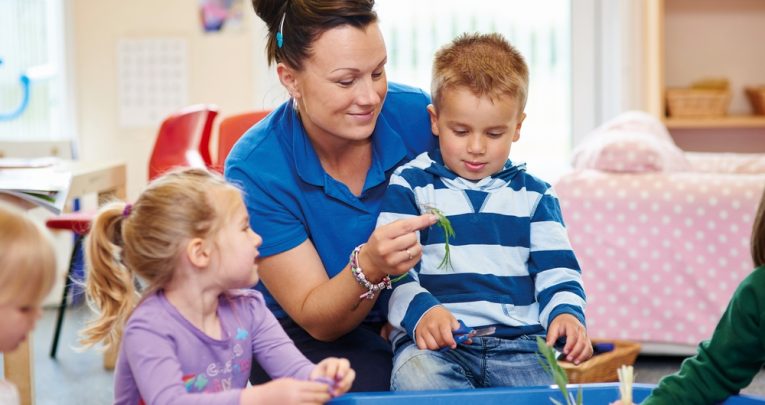What makes for an effective key person in an early years setting?

Overseeing the development of a group of unique children, communicating with their parents and managing your own emotional attachments takes outstanding skills, as Michael Freeston explains…

When my daughter attended nursery she had what the Early Years Foundation Stage would consider to be the perfect key person in Julie.
Julie (not her real name) performed all the functions of a key person outlined in the framework. She was keen to tell me when I picked my daughter up of the events of the day, and that all her learning and care had been tailored to meet her needs – and in so doing, she no doubt demonstrated the EYFS requirement to “Engage and support parents and/or carers in guiding their child’s development at home.” (1.10) [PDF] But while Julie performed the role of key person very well, she was perhaps not being a key person in its true sense of being, as described in Alliance publication Being a Key Person in an Early Years Setting – “A significant, important, priority, valued, valuable, crucial, top-of-the-list, special, fundamental, foremost and essential person in a child’s experience within an early years setting.” Because truly being a key person requires a relationship-based approach to working with children, and poses challenges for the individuals themselves, between staff, for the managers and for a setting as a whole…
Key skills
Beyond vocational skills and competence, individual key persons require personal characteristics of empathy, patience and genuine concern, as well as knowledge of child development (particularly attachment and transition) and how interventions impact differently on each child. All key persons must reflect on how they care for each of their children, and hold every one in their mind in a way that demonstrates commitment to each individual – how they describe their feelings for each child; whether they are finding it hard to feel as strongly towards a particular child, who this can be discussed with and how it can be addressed, so that the child does not miss out on experiencing a positive supportive relationship while in their care. Being an effective key person also requires maintaining strong relationships with parents and carers. Attention is often paid – and rightly so – to effective engagement with parents during the ‘Getting to know you’ stage of settling in. However, the key person must develop a three-way (or triadic) relationship built on trust, communication, sharing information, listening, planning and working together. The key person contributes knowledge about general child development and learning, while the parents provide the personalised knowledge about their child.
These two sets of knowledge interact to really open up an understanding of the child for both parties. Being a key person is therefore very demanding, particularly in cases where an individual may have a large key group of children and even – as can be the case in some settings – more than one key group at a time. This means that there will be challenges for colleagues and the setting as a whole to support an individual to be a key person. Where settings operate a back-up key person system, this will help children’s sense of security by letting them know that there is another member of staff they can depend on if their key person is not there. Working in pairs also provides an additional pair of eyes, observing children in the setting and adding to the pool of knowledge about them.
In this way, practitioners can be resources for one another, sharing skills, insights, ideas and knowledge – learning from each other, tuning into each other and creating a culture of reflective practice and sustained shared thinking that supports each child’s experience and improves practice across the setting as a whole.
Management challenges
Clearly, creating a setting where staff can develop the relationships that allow them to truly be key persons poses considerable challenges to a manager. Regular and effective supervision meetings are essential to allow key persons to discuss their work and their key children. These sessions also provide an opportunity for managers to check that the key person is content in themselves, and that the emotional demands of being a key person are being managed effectively.
The closeness of the key person’s relationship with a child can sometimes become overwhelming in cases where they are concerned about the child’s welfare. The manager thus also needs to ensure that a professional perspective is maintained. The procedures and structures of a setting have to create an environment where key person relations can flourish. Settling-in arrangements set the tone through which the three-way partnership between child, parent and practitioner can develop. For the baby or child, feeling safe in exploring the new environment, getting used to being separated from the parent and getting to know the key person is essential. The process needs to be a graduated approach. ‘Settling in’ equally applies to parents, who need to become comfortable with the key person, other members of staff and the setting’s routines. Space and time need to be set aside as part of the setting’s daily routine, so that this three-way relationship can develop effectively. This all serves to put pressure on the setting’s available resources, of course, which the manager will have to carefully balance. Ultimately, in order for staff to truly be key persons, each practitioner needs to be a contented individual whose own sense of wellbeing is high. As such, a setting manager has to create a working environment that nurtures practitioners, so they feel comfortable in raising and discussing issues within the team, and are able to reflect on their key children’s developmental and care needs.
For key persons
If you’re a key person yourself, try reflecting on the following points…
• When you were a child, who were you most attached to?
• How did you feel when you were separated from this person?
• How do you care for each child in your key group and demonstrate your commitment towards them?
Trending
• How would you describe what you feel for each child?
• If you are finding it hard to feel the same level of commitment to a particular child, who can you discuss this with so the child does not miss out whilst in your care?
• How will you cope when a child to whom you have become attached moves on?
For managers
If you’re currently leading or managing key persons within your setting, consider the following points…
• Are your supervision sessions purposeful, allowing the key person to share their knowledge of their key children?
• Is the culture of your setting one where all staff are valued, and where knowledge and insights into all the children are shared in a constructive and non-judgemental way?
• Do your settling-in procedures provide the space and time for positive relationships to be established between key person, child and parent/carer?
Being a Key Person in an Early Years Setting (2015) is available to purchase from the Pre-school Learning Alliance’s online shop.
Michael Freeston is Director of Quality Improvement at the Pre-school Learning Alliance; for more information, visit www.pre-school.org.uk or follow @pre_schoolla








